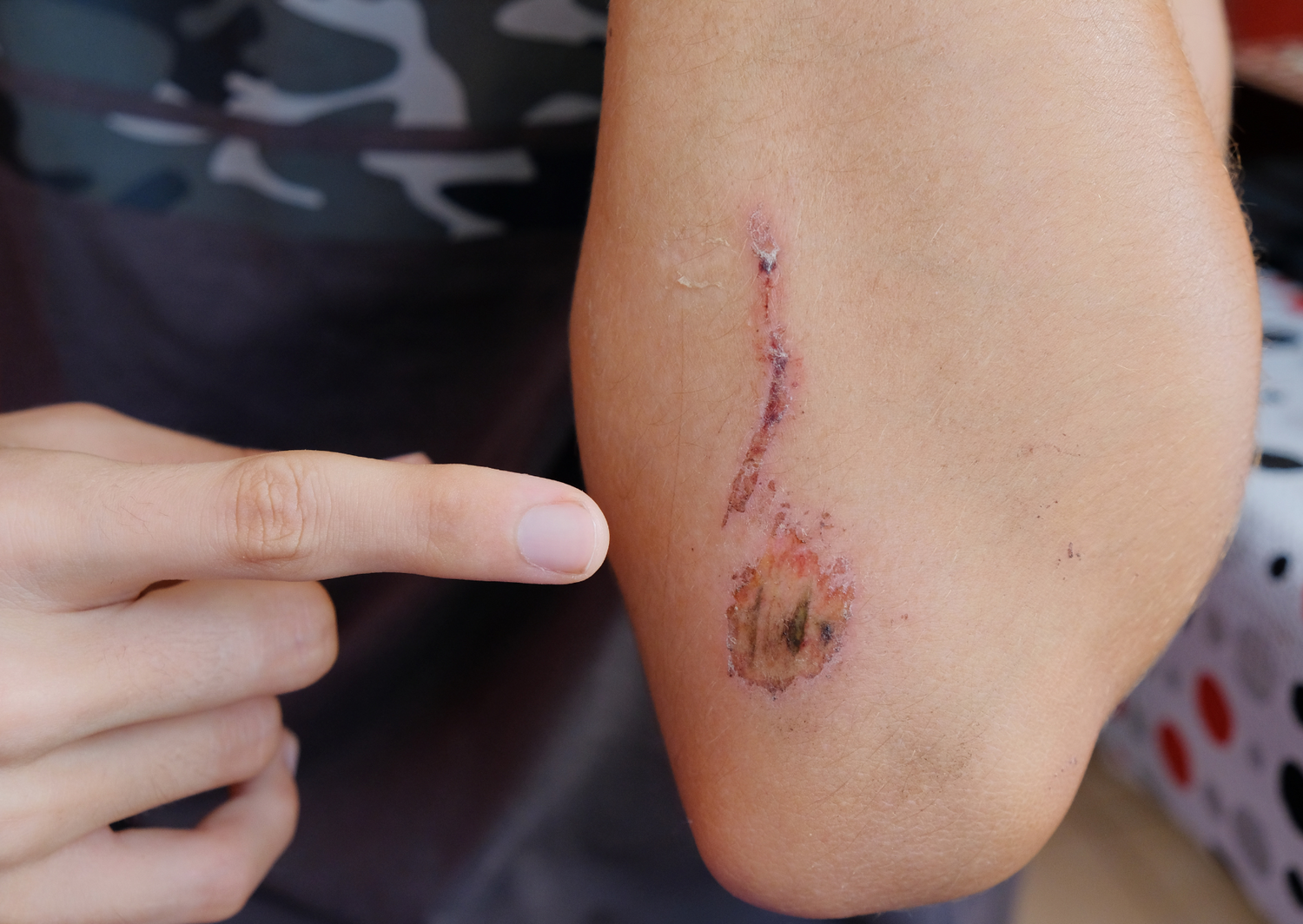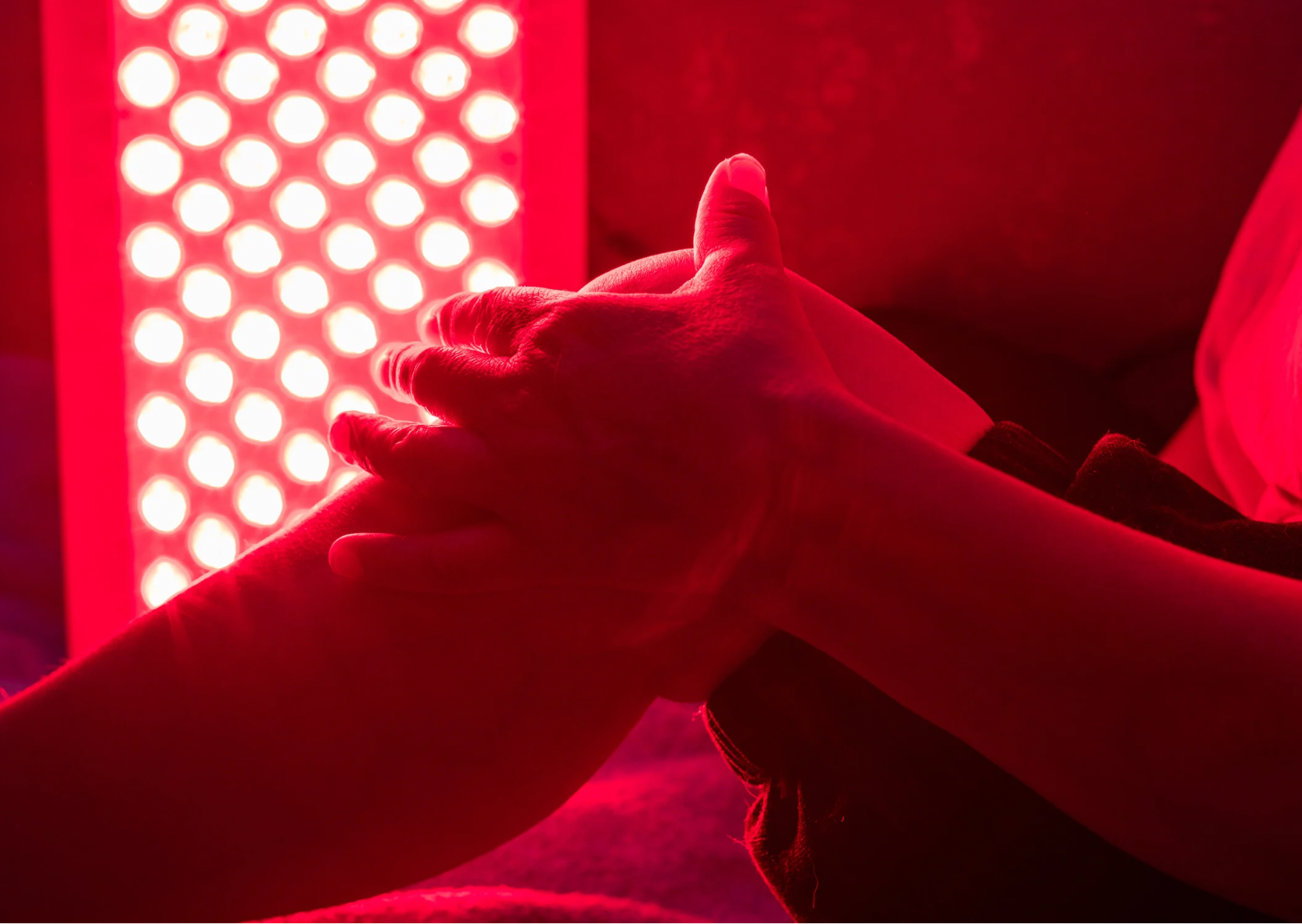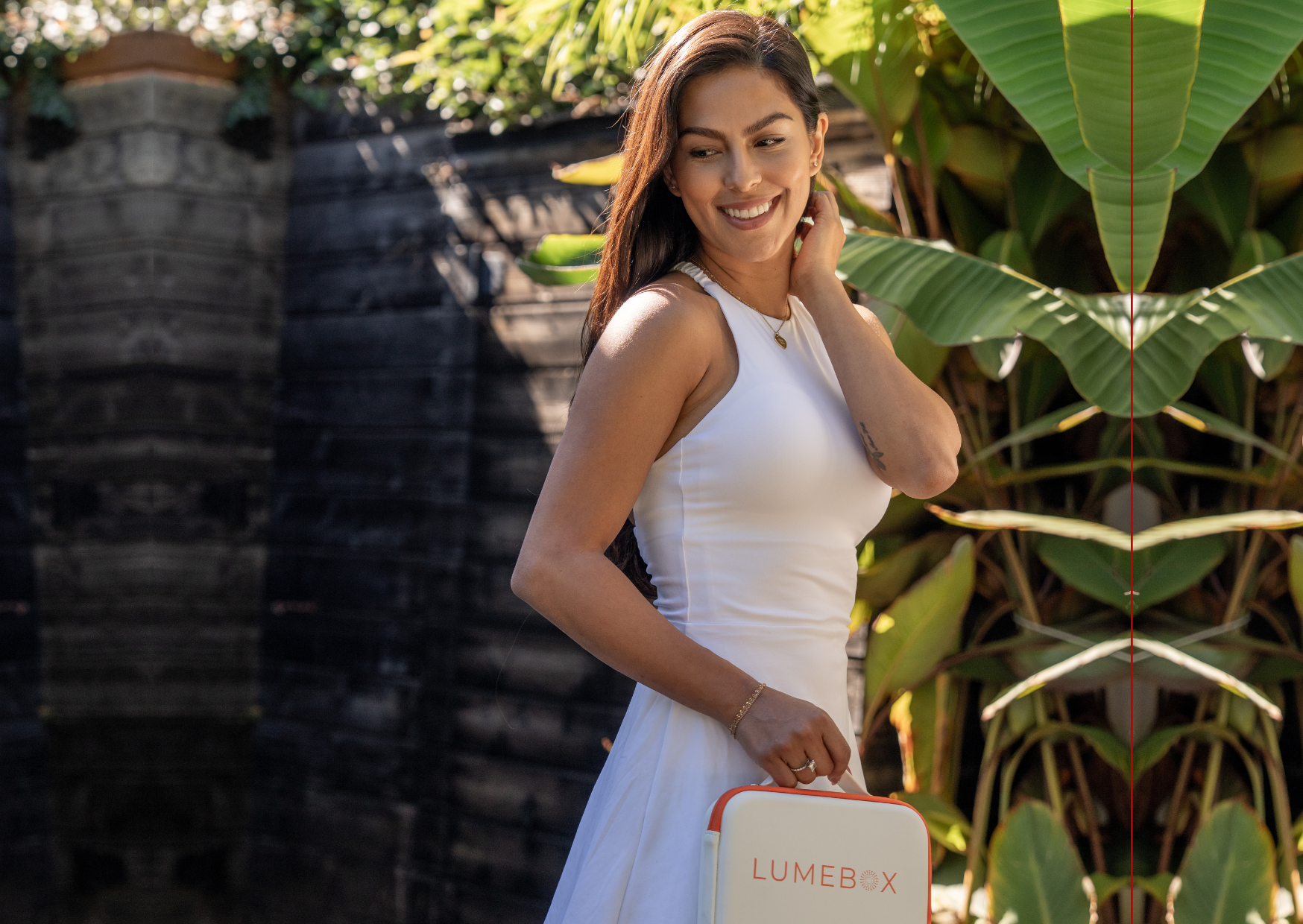We've all dealt with various wounds, from cuts and scrapes to burns, bruises, bites, blisters. Sometimes these wounds reopen, get infected, or become chronic, like a blister that lingers. But wouldn’t it be cool if we could support the body’s innate ability to heal itself?
Light can be restorative
Scientific research suggests that light wavelengths in the red (600–700 nm) and near-infrared (770–1200 nm) ranges may penetrate the skin barrier, increase blood flow [2], ease inflammation, and temporarily relieve pain [3].
How does a wound naturally heal?
Wound healing is a complex process in the body, but in the example of a wound like a cut or scrape, it can be simplified into 4 steps [4]:
-
The Restriction of blood flow
The blood starts to clot within the first few hours of a cut or scrape.
-
Inflammatory response
Believe it or not, the heat, redness, and swelling around a wound serve a function. The increased blood flow brings essential nutrients and building blocks needed for tissue repair. Additionally, our immune system, especially the white blood cells, actively works to eliminate bacteria and other foreign substances from the wound. This typically occurs within 24 hours after an injury.
-
Formation of the scab
A few days later, once the blood clot has dried and the swelling decreases, collagen and fibrous tissue swoop in to get our skin back to its previous appearance.
- Remodeling
New skin forms and strengthens to repair the wound, and scarring is also common. This phase can take as little as 3 weeks but can continue for two years or more.
A wound is considered acute if it heals within a few weeks. However, if a wound doesn't heal within three months, it's classified as chronic.
Such persistent wounds can be problematic. They can be common in conditions like diabetes where wound healing is impaired, so it's important to consult your doctor for appropriate treatment options.
Can red light play a role in wound healing?
Over 50 years ago, a scientist from Hungary accidentally found that red laser light, when applied at a low dose to the backs of white mice, not only promoted hair regrowth but also wound healing [5].
Research on red light therapy exploded after NASA discovered that astronauts using red light to grow plants in space also experienced faster healing of wounds on their hands under this light… and this got them thinking. Could red light play a supportive role in human wound care?
There’s a large body of research on animals like rats [6] and mice, as well as larger animals like cattle [7], but let's be honest - the research on humans is what we’re interested in.
Here’s what the science says.
The studies
Red light therapy is not a 'cure' or ‘treatment’ for wounds. If you have a wound, especially a surgical one, it's important to consult your doctor before starting red light therapy. The suitability of light therapy depends on the nature of the surgery and any materials that may interact with the light.
However, the following studies using LEDs and lasers are encouraging and worth discussing with your doctor.
Study 1:
A double-blind, randomized, placebo-controlled trial [8] studied 23 diabetic leg ulcers across two groups of 14 patients with type II diabetes.
After cleaning the ulcers, LED red light therapy was delivered:
- Wavelength: 660 nm RED and 890 nm NIR (similar wavelengths to what LUMEBOX emits)
- Irradiance: 100 mW/cm2 (LUMEBOX emits around 125 mW/cm² or red light from 1cm away - to reduce irradiance, simply move your LUMEBOX further away)
- Duration: 30 seconds, two times per week
- Dose: 3 J/cm²
What the study found:
By day 90, 58.3% of the red light therapy group ulcers had healed fully and 75% had achieved 90-100% healing.
In contrast, only one "placebo" treated ulcer healed fully by day 90 - this study shows that LED-based red light therapy even at low doses could potentially help wounds heal faster.

Study 2:
A double-blind, randomized trial [9] on 60 patients with chronic diabetic wounds below the knee treated patients with either active LED red light therapy, or a control.
The LED device delivered:
- Wavelength: 3 wavelengths (635, 660nm = red, and 850 nm = near-infrared)
- Duration: 5 minutes, three times per week for 8 weeks
- Power/irradiance: 2.4 J/cm2 (this equates to an irradiance of around 8mw/cm2) during each exposure
- Use notes: Device held 10cm from the wound
Before starting treatment, doctors took a small amount of blood to check the number of blood cells. They also looked at pictures of wounds and used a special tool called the Falanga wound bed score to see how well the wounds were healing. This tool looks at things like wound granulation (tissue repair), the presence of a substance called fibrin that helps blood clot, and the fluid the body uses to heal wounds in response to inflammation.
What they found:
After 4 weeks, the Falanga wound bed score was significantly better in the LED group than in the control.
In the red light group, irradiation “induced healing of chronic diabetic wounds by improving wound granulation”.
Wound granulation is a crucial phase in wound healing because this new tissue, often appearing as a red or pink layer of skin, helps to fill and close the wound over time. This tissue is rich in collagen and capillaries, which facilitate the access of nutrients and oxygen to the wound, essential for skin repair.
So, light therapy helped the wounds heal better by promoting tissue regeneration and increasing the presence of blood vessels.
Study 3:
A series of case studies were conducted using low-intensity LED therapy (658 nm = RED) to aid the healing of burns [11].
5 patients with second or third-degree burns in the arm, forearm, thorax, or lower limb region received light at a red wavelength with variable doses depending on the size of the burn, with some individuals receiving up to 662.4 J after 10 irradiations. The LED probe was applied directly to the wound surface.
Biopsies (cell samples) of the skin were taken, and photographs were taken throughout to document the healing process. Patients with burns affecting both sides had one limb irradiated and the other served as a control for comparison.
“There was a faster clinical improvement in the irradiated limbs.”
Here’s why: “The burns treated with LED showed higher epithelization, with keratinocytes and fibroblast proliferation, increased collagen synthesis, decreased pain, and pruritus.”
To cut the scientific jargon, the red light group experienced more skin growth over the wound because more collagen and tissue were made during the healing process. This not only strengthened the skin but also reduced the pain and itchiness associated with the wound.
Note this study ONLY used red light wavelengths. We recommend you check with your doctor if you have a burn, as this is a small study and the findings cannot be used to draw clinical conclusions yet.
How to use Red Light Therapy
Red light therapy may aid the body’s natural healing processes by supporting healthy inflammation [12], improving blood flow, activating the fibroblasts by modulating growth factors [13] (the cells that make collagen in our body), and helping improve the appearance of scar tissue [13].
Red wavelengths are often more suitable for skin and surface wounds. We recommend discussing with your doctor and considering a low starting dose because…
…currently, there's no standard agreement on the ideal treatment duration or dosage for Red Light Therapy, as different tissues might need varying amounts of light to achieve the desired effects.
The studies suggest that:
- Red light alone might be best.
- Not too much light is needed.
Side note: Once you’ve checked with your doctor that it’s okay to use red light therapy on the wound, just one cycle a day (12 minutes max!) of LUMEBOX in RED mode, about 2 inches away from a surface wound, would provide about the same ‘dose’ mentioned in the studies (but do check with your doctor, as everyone is different).
This variability is why we include a Kickstarter Guide with each LUMEBOX purchase, tailored to its specific irradiance, which suits most users. However, individual responses can vary, so it's important to consult with your doctor before starting treatment.
Happy Healing!
New to red light therapy? Download our free eBook to help you choose the best device.
Already have a LUMEBOX? Download our 6 time-saving tricks guide!
Medical Disclaimer: The information contained in this blog post is intended for educational purposes only and should not be used as medical advice. Everyone responds to light differently. Testimonials are not a guarantee of the results you or anyone who uses LUMEBOX will get because your success depends entirely on your circumstances, and the studies on red light therapy shared were not specifically performed using LUMEBOX. Please check with your doctor before using red light therapy and do not change your medical treatments or lifestyle without consulting your physician first.
References:
[1] Grzybowski, A., Sak, J., & Pawlikowski, J. (2016). A brief report on the history of phototherapy. Clinics in Dermatology, 34(5), 532-537. https://doi.org/10.1016/j.clindermatol.2016.05.002
[2] Mak, M. C., & Cheing, G. L. (2012). Immediate effects of monochromatic infrared energy on microcirculation in healthy subjects. Photomedicine and laser surgery, 30(4), 193–199. https://doi.org/10.1089/pho.2011.3012
[3] Cheng, K., Martin, L. F., Slepian, M. J., Patwardhan, A. M., & Ibrahim, M. M. (2021). Mechanisms and Pathways of Pain Photobiomodulation: A Narrative Review. The journal of pain, 22(7), 763–777. https://doi.org/10.1016/j.jpain.2021.02.005
[4] Leyane, T. S., Jere, S. W., & Houreld, N. N. (2021). Cellular Signalling and Photobiomodulation in Chronic Wound Repair. International journal of molecular sciences, 22(20), 11223. https://doi.org/10.3390/ijms222011223
[5] Mester, E., Spiry, T., Szende, B., & Tota, J. G. (1971). Effect of laser rays on wound healing. The American Journal of Surgery, 122(4), 532-535. https://doi.org/10.1016/0002-9610(71)90482-X
[6] Mosca RC, Santos SN, Nogueira GEC, Pereira DL, Costa FC, Pereira JX, Zeituni CA, Arany PR. The Efficacy of Photobiomodulation Therapy in Improving Tissue Resilience and Healing of Radiation Skin Damage. Photonics. 2022; 9(1):10. https://doi.org/10.3390/photonics9010010
[7] Ghamsari, S. M., Taguchi, K., Abe, N., Acorda, J. A., Sato, M., & Yamada, H. (1997). Evaluation of low level laser therapy on primary healing of experimentally induced full thickness teat wounds in dairy cattle. Veterinary surgery : VS, 26(2), 114–120. https://doi.org/10.1111/j.1532-950x.1997.tb01473.x
[8] Minatel, D. G., Frade, M. A., França, S. C., & Enwemeka, C. S. (2009). Phototherapy promotes healing of chronic diabetic leg ulcers that failed to respond to other therapies. Lasers in surgery and medicine, 41(6), 433–441. https://doi.org/10.1002/lsm.20789
[9] Frangež, I., Nizič-Kos, T., & Frangež, H. B. (2018). Phototherapy with LED Shows Promising Results in Healing Chronic Wounds in Diabetes Mellitus Patients: A Prospective Randomized Double-Blind Study. Photomedicine and laser surgery, 36(7), 377–382. https://doi.org/10.1089/pho.2017.4382
[10] Trelles, M. A., & Allones, I. (2006). Red light-emitting diode (LED) therapy accelerates wound healing post-blepharoplasty and periocular laser ablative resurfacing. Journal of Cosmetic and Laser Therapy, 8(1), 39-42. https://doi.org/10.1080/14764170600607731
[11] de Oliveira, R. A., Boson, L. L. B., Portela, S. M. M., Maia Filho, A. L. M., & Santiago, D. de O. (2018). Low-intensity LED therapy (658 nm) on burn healing: a series of cases. Lasers in Medical Science, 33(4), 729-735. https://doi.org/10.1007/s10103-017-2399-z
[12] Hamblin M. R. (2017). Mechanisms and applications of the anti-inflammatory effects of photobiomodulation. AIMS biophysics, 4(3), 337–361. https://doi.org/10.3934/biophy.2017.3.337
[13] Avci, P., Gupta, A., Sadasivam, M., Vecchio, D., Pam, Z., Pam, N., & Hamblin, M. R. (2013). Low-level laser (light) therapy (LLLT) in skin: stimulating, healing, restoring. Seminars in cutaneous medicine and surgery, 32(1), 41–52.






